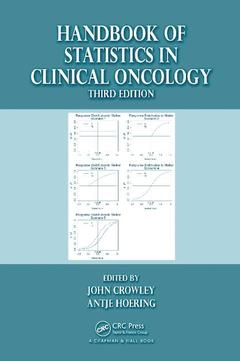Description
Handbook of Statistics in Clinical Oncology (3rd Ed.)
Coordinator: Crowley John
Language: English
Subjects for Handbook of Statistics in Clinical Oncology:
Keywords
Choosing a Phase I Design; CRM Trials for Assessing Toxicity and Efficacy; Early Stopping of Clinical Trials; Forensic Bioinformatics; PBMC Assay; Noninferiority Trials; SWOG Trial S0023; Interim Analysis; Non-inferiority Trials; Dose Level; EGFR Fish; CRM Design; AR; CRM; PFS Endpoint; Marker Positive Patients; Log Hazard Ratio; DLT; BRCA1 Mutation; Mm Patient; Brier Score; Correct Selection Probability; Log Rank Statistic; Dose Toxicity Curve; HER2 Negative Breast Cancer; Expected Sample Size; SWOG Trial; Predictive Marker; PP
Publication date: 09-2017
· 15.6x23.4 cm · Paperback
Publication date: 02-2015
635 p. · 15.6x23.4 cm · Hardback
Description
/li>Contents
/li>Readership
/li>Biography
/li>
Many new challenges have arisen in the area of oncology clinical trials. New cancer therapies are often based on cytostatic or targeted agents, which pose new challenges in the design and analysis of all phases of trials. The literature on adaptive trial designs and early stopping has been exploding. Inclusion of high-dimensional data and imaging techniques have become common practice, and statistical methods on how to analyse such data have been refined in this area. A compilation of statistical topics relevant to these new advances in cancer research, this third edition of Handbook of Statistics in Clinical Oncology focuses on the design and analysis of oncology clinical trials and translational research.
Addressing the many challenges that have arisen since the publication of its predecessor, this third edition covers the newest developments involved in the design and analysis of cancer clinical trials, incorporating updates to all four parts:
- Phase I trials: Updated recommendations regarding the standard 3 + 3 and continual reassessment approaches, along with new chapters on phase 0 trials and phase I trial design for targeted agents.
- Phase II trials: Updates to current experience in single-arm and randomized phase II trial designs. New chapters include phase II designs with multiple strata and phase II/III designs.
- Phase III trials: Many new chapters include interim analyses and early stopping considerations, phase III trial designs for targeted agents and for testing the ability of markers, adaptive trial designs, cure rate survival models, statistical methods of imaging, as well as a thorough review of software for the design and analysis of clinical trials.
- Exploratory and high-dimensional data analyses: All chapters in this part have been thoroughly updated since the last edition. New chapters address methods for analyzing SNP data and for developing a score based on gene expression data. In addition, chapters on risk calculators and forensic bioinformatics have been added.
Accessible to statisticians and oncologists interested in clinical trial methodology, the book is a single-source collection of up-to-date statistical approaches to research in clinical oncology.
Choosing a Phase I Design. Dose Finding Designs Based on the Continual Reassessment Method. Pharmacokinetics in Clinical Oncology: Statistical Issues. Statistics of Phase 0 Trials. CRM Trials for Assessing Toxicity and Efficacy. Seamless Phase I/II Trial Design for Assessing Toxicity and Efficacy for Targeted Agents. Overview of Phase II Clinical Trials. Designs Based on Toxicity and Response. Designs Using Time to Event Endpoints/Single Arm versus Randomized Phase II. Phase II Selection Designs. Phase II with Multiple Subgroups: Designs Incorporating Disease Subtype or Genetic Heterogeneity. Phase II/III Designs. On Use of Covariates in Randomization and Analysis of Clinical Trials. Factorial Designs with Time to Event Endpoints. Early Stopping of Clinical Trials. Noninferiority Trials. Phase III Trials for Targeted Agents. Adaptive Trial Designs. Design of a Clinical Trial for Testing the Ability of a Continuous Marker to Predict Therapy Benefit. Software for Design and Analysis of Clinical Trials. Cure-Rate Survival Models in Clinical Trials. Design and Analysis of Quality of Life Data. Economic Analyses alongside Cancer Clinical Trials. Structural and Molecular Imaging in Cancer Therapy Clinical Trials. Prognostic Factor Studies. Predictive Modeling of Gene Expression Data. Explained Variation and Explained Randomness for Proportional Hazards Models. Prognostic Groups by Tree-Based Partitioning and Data Refinement Methods. Risk Calculators. Developing a Score Based upon Gene Expression Profiling and Validation. Analysis of DNA Microarrays. Methods for SNP Regression Analysis in Clinical Studies: Selection, Shrinkage, and Logic. Forensic Bioinformatics. Index.
John J. Crowley is president and CEO of Cancer Research and Biostatistics (CRAB), Seattle, Washington, director of the SWOG Statistical Center, and a faculty member at the Fred Hutchinson Cancer Research Center. The author or coauthor of more than 350 refereed articles, book chapters, and other publications, Dr. Crowley is a fellow of the American Statistical Association and the American Association for the Advancement of Science and a member of the International Biometrics Society, the American Society for Clinical Oncology, and the International Association for the Study of Lung Cancer. He received his BA (1968) from Pomona College, Claremont, California, and his MS (1970) and PhD (1973) in biomathematics from the University of Washington, Seattle.
Antje Hoering, PhD, is a senior biostatistician at Cancer Research and Biostatistics (CRAB), Seattle, Washington. She is also an affiliate faculty member in the Department of Biostatistics at the University of Washington and an affiliate investigator at the Fred Hutchinson Cancer Research Center. Dr. Hoering is the lead statistician of the SWOG Myeloma Committee, the SWOG Early Therapeutics Subcommittee, and the Stand Up To Cancer, Pancreatic Dream Team. She is the coordinating statistician for the Myeloma Institute for Research and Therapy, the International Myeloma Committee, and the Pancreatic Cancer Research Team. She serves as a consultant on a variety of industry-sponsored studies and has been the biostatistics representative on two Type B meetings with the FDA. She is member of the American Statistical Association, the International Biometrics Society, and the International Myeloma Society. She received her BS (1985) from the University of Tubingen, Germany, her MS (1988) in physics from Oregon State University, Corvallis, and her PhD (1991) in physics from the Max Planck Institute for Theoretical Nuclear Physics, Heidelberg, Germany. She transitioned into biostatistics




